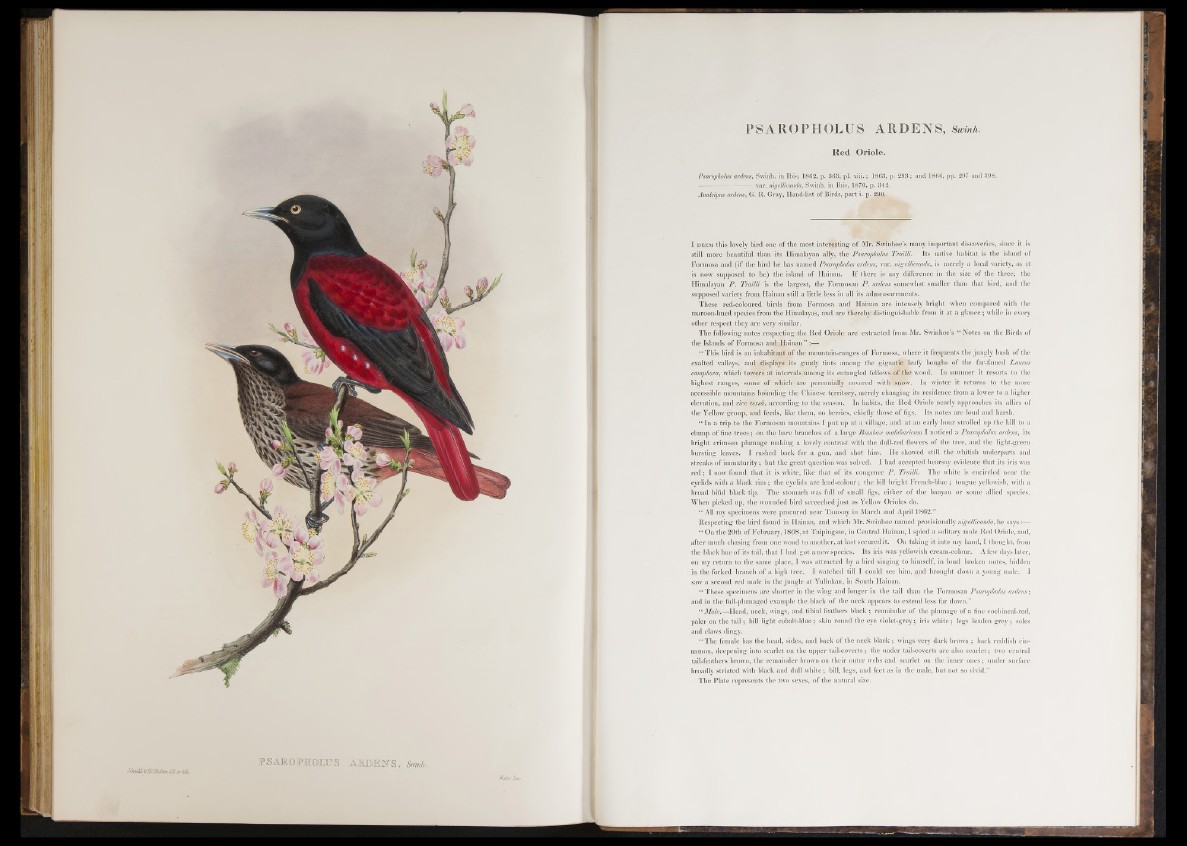
PSAROPHQUTS A M E f fS , SmnA
WalterJmp.
P S A R O P H O L U S A R D E N S , Swinh.
Red Oriole.
Psaropholus ardens, Swinh. in Ibis, 1862, p. 363, pi. xiii.; 1863, p. 293; and 1866, pp. 297 and 398.
— var. nigellicauda, Swinh. in Ibis, 1870, p. 342.
Analcipus ardens, G. R. Gray, Hand-list of Birds, p art i. p. 290.
I d e e m this lovely bird one of the most interesting of Mr. Swinhoe’s many important discoveries, since it is
still more beautiful than its Himalayan ally, the Psaropholus Trailli. Its native habitat is the island of
Formosa and (if the bird he has named Psaropholus ardens, var. nigellicauda, is merely a local variety, as it
is now supposed to be) the island of Hainan. I f there is any difference in the size of the three, the
Himalayan P . Trailli is the largest, the Formosan P . ardens somewhat smaller than that bird, and the
supposed variety from Hainan still a little less in all its admeasurements.
These red-coloured birds from Formosa and Hainan are intensely bright when compared with the
maroon-hued species from the Himalayas, and are thereby distinguishable from it at a glance; while in every
other respect they are very similar.
The following notes respecting the Red Oriole are extracted from Mr. Swinhoe’s “ Notes on the Birds of
the Islands of Formosa and /Hainan ”
“ This bird is an inhabitant of the mountain-ranges o f Formosa, where it frequents the jungly bush of the
exalted valleys, and.displays its gaudy tints among the gigantic leafy boughs of the far-famed Laurus
camphora, which towers at intervals iamong its entangled fellow s« tb^ wood. In summer it resorts to the
highest ranges, some o f which are perennially covered with ‘show. In winter it returns to the more
accessible mountains bounding the Chinese territory, merely changing its residence from a lower to a higher
elevation, and vice versa, according to the season. In habits, the Red Oriole nearly approaches its allies of
the Yellow group, and feeds, like them, on berries, chiefly those of figs. Its notes are loud and harsh.
“ In a trip to the Formosan mountains I put up at a village, and a t an early hour strolled up the bill to a
clump of fine tre e s ; on the bare branches of a large Bomhax malabaricum I noticed a Psaropholus ardens, its
bright crimson plumage making a lovely contrast with the dull-red flowers of the tree, and the light-green
bursting leaves. I rushed back for a gun, and shot him. He showed still the whitish underparts and
streaks of immaturity; but the great question was solved. I had accepted hearsay evidence that its iris was
r e d ; I now found that it is white, like that of its congener P . Trailli. The while is encircled near the
eyelids with a black rim ; the eyelids are lead-colour; the bill bright French-blue; tongue yellowish, with a
broad bifid black tip. The stomach was full o f small figs, either of the banyan or some allied species.
When picked up, the wounded bird screeched just as Yellow Orioles do.
“ All my specimens were procured near Tamsuy in March and April 1862.”
Respecting the bird found in Hainan, and which Mr. Swinhoe named provisionally nigellicauda, he says
“ On the 20th of February, 1868, at Taipingsze, in Central Hainan, I spied a solitary male Red Oriole, and,
after much chasing from one wood to another, a t last secured it. On taking it into my hand, I thought, from
the black hue o f its tail, that I had got a new species. Its iris was yellowish cream-colour. A few days later,
on my return to the same place, I was attracted by a bird singing to himself, in loud broken notes, bidden
in the forked branch of a high tree. I watched till I could see him, and brought down a young male. I
saw a second red male in the jungle at Yulinkan, in South Hainan.
“ These specimens are shorter in the wing and longer in the tail than the Formosan Psaropholus ardens;
and in the full-plumaged example the black of the neck appears to extend less far down.”
“Male.—Head, neck, wings, and tibial feathers black ; remainder of the plumage of a fine cochineal-red,
paler on the t a il; bill light cobalt-blue; skin round the eye violet-grey; iris white; legs leaden grey ; soles
and claws dingy.
“ The female has the head, sides, and back of the neck black ; wings very dark brown ; back reddish cinnamon,
deepening into scarlet on the upper tail-coverts; the under tail-coverts are also scarlet; two central
tail-feathers brown, the remainder brown on their outer webs and scarlet on the inner ones; under surface
broadly striated with black and dull white; bill, legs, and feet as in the male, but not so vivid.”
The Plate represents the two sexes, of the natural size.